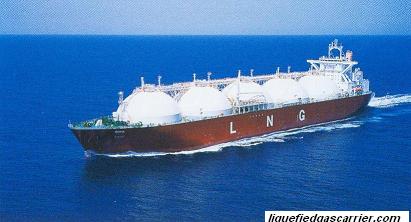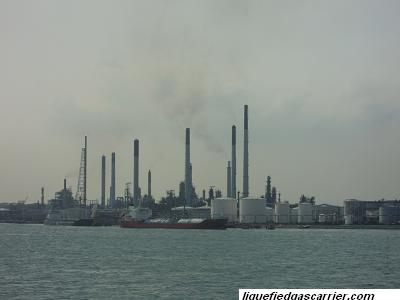

Home page|||
LNG handling |||
LPG handling||| Other Gas products|||
Fire & Safety|||
Emergency response |||
Equipment failure & emergency response for liquefied gas carriers
An emergency can occur at any time and in any situation. Effective action is only possible if pre-planned and practical procedures have been developed and are frequently exercised.
The Contingency Plan provides guidelines and instructions that assist in making an efficient response to emergency situations onboard ships.
If the vessel encounters a dangerous situation that may develop into an emergency, it is extremely important that the whole crew know exactly what they should do to save their lives and minimize damage.
The crew must be drilled to take certain actions more or less automatically. However, nobody must act without considering the superfluous consequences.
These plans should be used actively during emergency drills.
Bridge Control/Engine Telegraph Failure and Immediate Action
In co-ordination with duty engineer, switch to Engine Room Control
a) Inform the Master
b) Use emergency telegraph
c) Engine room to be attended during any bridge control failure
d) Consider - suspending berthing/leaving berth or leaving/entering port

Gyrocompass Failure
e) If the gyrocompass has failed, where a second gyrocompass is available make the second one active.
f) Change to manual steering and steer the vessel by magnetic compass, keeping in mind correction to be applied
g) Inform the Master
h) Enter heading in both radar manually
i) Remember that heading may affect other navigational aids and Sat Communications
j) If GPS working keep monitoring Course in order to adjust course with magnetic compass
k) Reduce speed if considered necessary
l) Steer with Landmarks particularly when in proximity to port
Lost Anchor and Chain
a)Alert Port Authorities and Pilots in next port of call
b) Consider - order extra tugs for assistance or stand-by on arrival
c) Determine how much chain is left
d) Prepare full report to the Company
e) Inform CMSI
Main Engine Failure / Breakdown
a) Inform Master
b) Use rudder (Bow Thrusters) to the best advantage
c) Exhibit “Not Under Command” signal
d) Prepare to anchor if in shallow waters
e) Broadcast vessel in the vicinity
f) Consider - are tugboats required. Prepare emergency towing if required
g) Inform CMSI, Owners, Local Authorities, Agent, Insurance/P&I
h) Monitor Tank pressure
i)Stopping spraying, cooling down lines or other cargo operations may help to increase cargo tanks pressure
j) Consider - suspending berthing/leaving berth or entering/leaving port
Steering Failure
a) Inform Master
b) Try other available means- Change to stand -by pumps, change to Non Follow Up (NFU) mode
c) Engineer should inform the bridge at once as to the result of the initial check in order to act accordingly
d) If emergency steering has to be used (one pump running only) remember limitation regarding speed (max. speed normally half of sea speeds around 10 Knots).
e) Hoist /exhibit signal NUC (Not Under Command)
f) Reduce Speed or stop engines
g) Prepare anchor if in shallow waters
h) Broadcast warning to ships in the vicinity
i) Request Tug(s) if required
j) Consider - suspending berthing/leaving berth or entering/leaving port
k) When steering failure has been restored, cancel the broadcast warning
Mooring System Fails due to Tidal Effect or System Failure
The probability of this scenario occurring is remote as the moorings are continuously monitored whilst vessel is alongside. Also the tidal effect is predicted and monitored whilst the vessel is alongside.
Some vessels have access to mooring monitoring equipment that enables a continuous monitor of all moorings. Mooring failure during loading/unloading mainly occurs due to mooring equipment failure. Typical causes include: broken pipes, pumps, not enough oil in expansion tank, clogged filters, etc.
a) Advise CCR as soon as mooring failure is detected
b) Evaluate the extent of the failure. Maybe a mooring line or various mooring lines failed
c) Advise Terminal
d) Check mooring system. Look for hydraulic oil leaks, check oil level in expansion tank, check pumps, check if valves are properly lined up, run pumps and check filters
e) If one mooring line failed send another spare line (wire) if available, otherwise send ropes
f) If more than one mooring line failed arrange for tugboat(s) as soon as possible
g) All hands at their mooring stations to control the remaining mooring lines and send extra mooring lines ashore if possible
h) Stop loading operations. ESDS activated
i) Consider - disconnect loading arms and leave berth
j) If it has been decided to leave berth, make ready the main engine as soon as possible
k) Inform management, Owners, Local authorities, agent, P&I club

Ballasting Failure Causing Lost or Damaged Stability
a) Stop cargo operations
b) Advise terminal
c) Disconnect Loading arms in order to avoid damage
d) Monitor tanks pressure carefully
e) Monitor moorings and adjust as necessary
f) Reduce speed
g) Use minimum rudder angles
h) Choose comfortable course according to conditions
i) Give vessel position to GMDSS operator
j) Check, reason why stability is lost or damaged, flooding, leakage, slack ballast tanks, slack bunker tanks, shifted cargo or ballast
k) Consider - sounding the general alarm
l) Consider - distress call
m) Consider - preparing the survival craft
n) Considering alerting other vessels
o) When situation is under control, cancel your distress calls, and inform all contacts
Related Information:
Custody Transfer Measurement (CTM) System
Records of the calibration of key cargo instrumentation, including temperature and pressure gauges
The high level alarm system
Manifold arrangements
Safety equipment
Decontamination showers and an eye-wash
Cargo tank ruptures due to increased pressure - emergency procedure for gas carriers
Loss of power supplies - emergency actions
Risk and hazards of Equipment failure
Loss of Instrumentation during Unloading Operations - Recommended actions by Liquefied Gas carriers
Risk and hazards of Nitrogen Loss
Gas carriers Loss of Instrumentation during Loading Operations
Gas carriers Structural Damage due to Incorrect Loading/Unloading Sequence
Encountering High Winds and/or Waves - countermeasures
Safety guideline for changing previous cargo

// Home page///
LNG handling ///
LPG handling///
Sea transport ///
Gas products///
Cargo work
///Fire precautions
///Health hazards
///Safety Precautions
///Emergency response ///

Copyright © Liquefied Gas Carrie.com All rights reserved.
The content published in this website are for general reference only. We have endeavoured to make the information
as accurate as possible but cannot take responsibility for any errors. For latest information please visit www.imo.org .
Any suggestions, please Contact us !
///Links &Resources //
Terms of use///
Privacy policy///Home page///
